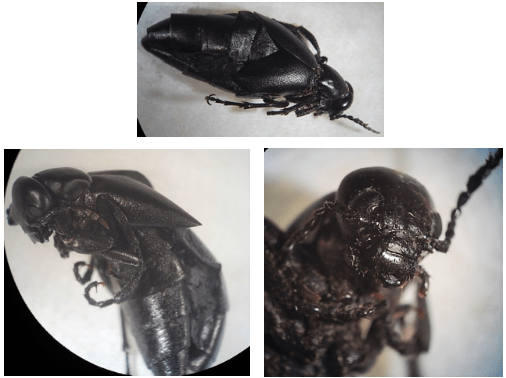Quantitating Cantharidin levels in a blister beetle
By Cat Barr, PhD, DABT
In January, an animal owner in northwestern Washington State contacted the Texas A&M Veterinary Medical Diagnostic Laboratory (TVMDL) regarding possible blister beetles on their property. Specifically, the animal owner was interested in measuring the amount of cantharidin in a sampling of the beetles. Cantharidin is a very potent blistering agent, causing colic, heart arrhythmias and potentially death in horses. It is toxic to all mammalian species.
TVMDL had previously quantitated cantharidin in a different type of blister beetle1 and therefore received three individual beetles for testing from the animal owner in early March. A single large beetle (see photos) had been found on a barn wall, and a mating pair caught in the act on a fence. Based on the position when caught, the male was smaller, and since the female was of similar size to the beetle from the barn wall, they were both presumed to be female. Studies of blister beetle behavior and cantharidin content indicate the male generates cantharidin and transfers it to the female at mating2. The beetles were designated Female 1, Female 2 (from the pair), and Male and determined to be short-winged blister beetles (Meloe sp.).

Photo 1, 2, 3: Three views of the largest of the three short-winged blister beetle (Meloe sp.) specimens submitted (taken using a dissecting microscope). Total length 26 mm, widest diameter 11mm. Note the thorax is narrower than either the head or the abdomen, and the mouth parts indicate an herbivore. These specimens were not definitively identified, and across North America there are several species of genus Meloe that look very similar in coloring and conformation (e.g., M. angusticollis, M. americanus). Their common name is oil beetle because they secrete fluid as a defense – the fluid causes blisters.
Using the published method for quantification of cantharidin from beetles3, each beetle was dried for several days at approximately 60oC, then weighed before being crushed to a powder for extraction. To verify the extraction was effective, a sample of three-stripe blister beetles (Epicauta temexa) was extracted and assayed alongside. Cantharidin was quantified against a solvent standard curve using gas chromatography/mass spectrometry (GC/MS). The following results were generated.
| Sample ID | Cantharidin, % dry matter basis | Cantharidin/ beetle, mg | # beetles to kill 1000 lb. horse (1 mg/kg) |
|---|---|---|---|
| Meloe sp. Female 1 | 0.39 | 1.5 | 303 |
| Meloe sp. Female 2 | 0.16 | 0.5 | 908 |
| Meloe sp. Male | 0.89 | 1.3 | 349 |
| Epicauta temexa, mixed, 6 beetles | 1.43 | 0.22 | 2064 |
Three-stripe blister beetles are known to contain 1-12 % cantharidin on a dry matter basis4.
A much larger sampling would be needed to characterize this beetle further with regard to cantharidin content. The data suggests that short-winged blister beetles are probably less toxic than the three-stripe blister beetle. Their effect on animal and human communities is dependent on feeding and swarming habits.
The method TVMDL uses to test animal clinical specimens for cantharidin exposure is much more sensitive than the method employed on these beetles. Poisoned animals (usually horses on alfalfa) generally have cantharidin concentrations in serum, urine, or stomach/cecal content in parts per billion (ppb) levels when they are showing clinical signs. TVMDL uses liquid chromatography with a triple quadrupole mass spectrometer (LC/MSn) to achieve the sensitivity needed. 1.0 % = 10,000 parts per million (ppm); 1 ppm = 1000 ppb.
Special thanks to Chemist Juan C. Castro for the GC/MS analyses.
- Barr AC, et al. Cantharidin poisoning of emu chicks by ingestion of Pyrota insulata. J Vet Diagn Invest 10(1):77-79 (1998).
- Brown WD, Stanford R. Male mating tactics in a blister beetle (Coleoptera: Meloidae) vary with female quality. Can J Zoo 70(9):1652-1665 (1992).
- Carpinera JL, et al. Cantharidin levels in blister beetles (Coleoptera: Meloidae) associated with alfalfa in Colorado. J Econ Entomol 78:1052-1055 (1985).
4. Ray AC, et al. Etiologic agents, incidence, and improved diagnostic methods of cantharidin toxicosis in horses. Am J Vet Res3(4):208-215 (1989).